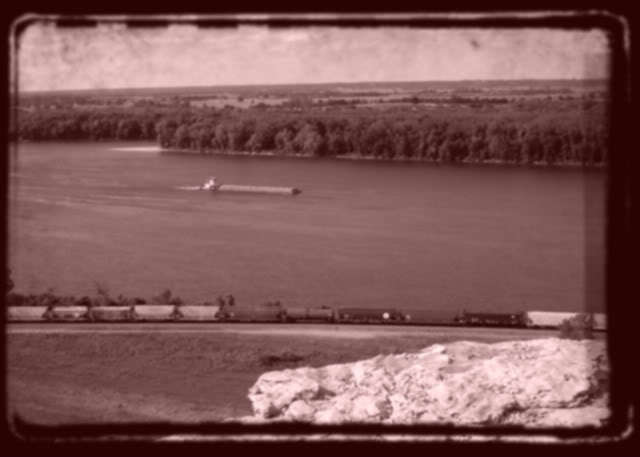Hannibal's Lovers Leap EarthCache
-
Difficulty:
-

-
Terrain:
-

Size:  (other)
(other)
Please note Use of geocaching.com services is subject to the terms and conditions
in our disclaimer.

Hannibal's Lovers Leap
On the southeast fringe of Hannibal, a majestic bluff rises above the surrounding area. This bluff is Hannibal’s own – and quite famous – Lovers Leap. A visit to Hannibal is not complete without a drive to the top of Lovers Leap to enjoy the panoramic view of the town and the broad valley of the Mississippi River.
This 250-foot bluff has inspired local legends, one of which involves an Indian maiden who commits suicide with her lover when rejected by their tribesmen or, conversely, jumps alone to her death to avoid marrying a warrior she does not love. While there are several possible sources for Hannibal's local legend, one claims that Hannibal newspaperman Orion Clemens created the legend. Orion was Samuel Clemens’ older brother.
Along with the legends of lovers leaping to their deaths, there is an actual, documented story involving Lovers Leap. With the belief that the world was coming to an end in 1843, William Miller from New York City Spread his doctrine well enough to have a strong following of people from Hannibal and the surrounding area. These “Millerites” were disappointed when 1843 came and passed without Armageddon, but held another vigil on October 22, 1844. They abandoned their crops and stores, put on long white robes, and waited on the crest of Lovers Leap. They continued to wait so they could be carried to heaven at the time of the Second Coming, which, according to available information, has still not yet transpired.
Geologically, Lovers Leap is composed of limestones, shales and siltstones capped by the Burlington Limestone, which, in turn, is capped by a layer of loess. These types of rocks were all formed by the deposition of sands, silts and other materials on ancient river and sea floors. Over time, they were compacted under huge amounts of pressure until they formed the rock we know today.
Of particular note, the Burlington Limestone is a marine limestone, found in rock layers laid down during the Mississippian Period (325-360 million years ago). The Mississippian Period was relatively short lasting - only 35 million years - and its fossil record consists of almost entirely marine fossils. This is due to the flooding of North America called the Kaskaskia transgression, which began during the Devonian Period (380-450 million years ago). This was interrupted at the end of the Devonian Period by partial regression, but deposition continued uninterrupted into the Mississippian Period. The Kaskaskia Sea reached its greatest extent about the middle of the Mississippian Period, and late Mississippian sedimentary rocks of the basins mark its recession. This recession also marks the boundary between the Mississippian and Pennsylvanian Periods in the North America.
The Burlington Limestone exposure here at Lovers Leap contains a multitude of fossils, while the loess contains swallow nests, hollowed out of the vertical face.
SOURCE: Geologic Wonders and Curiosities by Thomas R. Beveridge,
Second Edition, revised by Jerry D. Vineyard, 392 p., 163 figs., app., 1991.
To get credit for this EarthCache, go to the posted coordinates and answer the following questions. Please email them to me through my profile.
Any logs that do not follow these requirements will be deleted.
1. The three main stones that comprise the bulk of Lovers Leap are the Burlington Limestone, the Hannibal Shale and the Louisiana Limestone. Which stone do you think is comprised of the finest particles and why?
2. During what period and how many years ago was the Burlington Limestone laid down?
3. At the crest where you stand, you might be able to see some fossils. What fossils do you see? How big are they in general? (If you are unable to identify them by type, please describe what they look like.)
4. What is the elevation at the posted coordinates?
5. While completely optional and not required, it would be nice to post a photo of yourself with Lovers Leap behind you.

Additional Hints
(No hints available.)